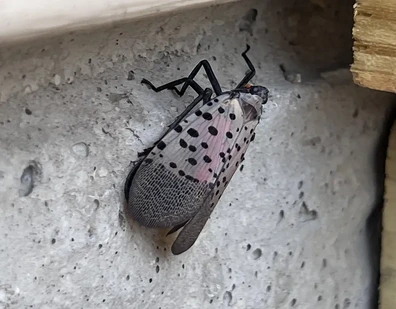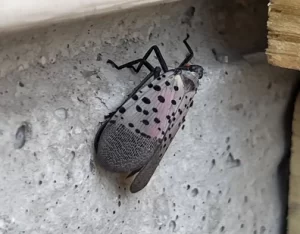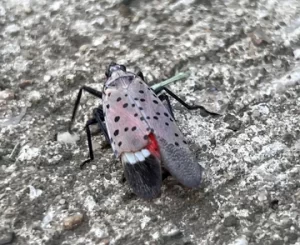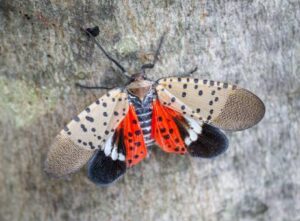Written & Edited By:
John Farmiloe
| Updated: March 10, 2024
The Pest Detective / Blog / Spotted Lanternfly Ohio

In 2024, sightings of the Spotted Lanternfly in Ohio spiked causing a lot of concern among entomologists and farmers in the state. This invasive species is native to Asia and poses a significant threat to Ohio’s ecosystems and agricultural industries, which is why any sightings of the insect should be reported to the Ohio Department of Agriculture’s Plant Pest Reporting Tool.
Written & Edited By:
| Updated: March 10, 2024
The Spotted Lanternfly (SLF) was first introduced to North America in 2014, when it was discovered in southeastern Pennsylvania. The invasive species, native to Asia, is thought to have arrived in the U.S. as egg masses on a stone shipment in 2012. Since then, the SLF has rapidly spread across multiple states, with infestations and individual sightings reported in areas such as New Jersey, Virginia, and more, posing a growing threat to agriculture and ecosystems. The first sighting of Spotted Lanternflies in Ohio was in Mingo Junction in 2020, since then they have become increasingly common in other areas of the state.
The Spotted Lanternfly is an insect from Asia that poses a serious threat to plants like grapes, hops, and apples, as well as many other types of vegetation. It’s especially worrying for the grape and wine industry in Ohio, which generated a whopping $6.6 billion in 2023 for the state’s economy.
Another concern regarding the Spotted Lanternfly is its favored host, the Tree of Heaven (Ailanthus altissima), itself an invasive species. However, SLF’s appetite extends far beyond the Tree of Heaven, making it a serious risk to vital crops. Grapes, in particular, are heavily impacted, and Ohio’s grape-growing industry could suffer substantial economic losses as SLF’s continue to spread. Hops, another favored plant, are essential for beer production, a significant agricultural commodity in Ohio. Beyond these crops, the lanternfly feeds on over 70 species of trees and plants, posing a considerable risk to the state’s biodiversity.
Related: How Much Is An Exterminator
These insects feed by piercing the bark of plants with their specialized mouthparts and sucking out sap. This sap-feeding weakens the plant by reducing its ability to produce nutrients, causing wilting, dieback, and stunted growth. Over time, this stress makes the plant more vulnerable to other pests and diseases, further damaging Ohio’s crops.
The loss of crops and plants isn’t just due to the physical damage the insects inflict. As SLF nymphs and adults feed, they excrete a sticky, sugary substance known as honeydew which coats leaves, stems, and fruit. This honeydew promotes the growth of a black, unsightly fungus called sooty mold, which reduces photosynthesis and diminishes the plant’s ability to thrive. In grapevines and hops, this can destroy entire harvests, leading to devastating economic losses for farmers. Additionally, SLF can swarm in large numbers, further exacerbating the problem for farms and home gardens alike.
In addition to the agricultural damage, SLF is also a significant nuisance for residents and businesses in infested areas. The insects often congregate in large numbers, covering trees, patios, and even homes. During peak activity periods, their swarms can disrupt daily life. The constant presence of honeydew on patios, decks, cars, and outdoor furniture leaves surfaces sticky and difficult to clean. The sight of the accumulating insects, combined with the mess they leave behind, has a substantial negative impact on quality of life for people living in infested areas.
Related Post: 6 Common Wolf Spiders in Ohio
Like many other poisonous and dangerous species on earth, Spotted Lanternflies are easily recognizable due to their strikingly beautiful appearance which can be compared to that of a butterfly. Adult lanternflies are about 1 inch long and have distinctive greyish wings with black spots when folded. When the wings are spread, you’ll notice their bright red underwings and a contrasting black-and-white band on their hind wings. Their abdomen is yellow with black bands. Nymphs, which are the younger stages, go through four stages of development. Early-stage nymphs are black with white spots, while later stages turn bright red with black and white markings.
You can find spotted lanternflies on trees, plants, and crops, particularly on their host tree, the invasive Tree of Heaven (Ailanthus altissima). They are commonly found on the trunks, branches, or leaves of these plants. They are especially attracted to areas with woody plants, but they can be found in gardens, orchards, forests, and even urban areas. These pests are more active during warm months, thriving in temperatures between 50°F to 90°F. However, they become less active as temperatures drop, but their egg masses can survive cold winters.



The spotted lanternfly has a one-year life cycle. It begins in the form of egg masses laid by females in late summer to early fall. These egg masses, which look like grayish-brown, mud-like smears, are laid on flat surfaces like tree trunks, rocks, fences, and even cars. The eggs remain dormant through the winter, hatching in the spring when temperatures rise.
After hatching, the insects enter their nymph stages. The first stage nymphs are tiny and black with white spots. They progress through four nymphal stages, growing larger with each stage. The later-stage nymphs turn red with black spots and white markings. Nymphs are highly active and jump from plant to plant, causing damage through sap-feeding.
By mid-summer, the nymphs mature into adult spotted lanternflies with their fully developed wings. These adults continue to feed on host plants, laying eggs as temperatures cool toward the fall. The cycle then repeats, with adults dying off after the first frost while the egg masses overwinter to begin a new generation.
The population of spotted lanternflies can grow rapidly and often go unnoticed in their early stages, making them a serious concern for Ohio. Their ability to lay numerous egg masses on various surfaces, combined with their spread through vehicles or shipments, allows infestations to escalate quickly. This rapid reproduction can lead to widespread damage before their presence is even detected.
The #1 way for the general public to help control the spread is by reporting ANY sightings of this invasive species to the Ohio Department of Agricultures tool: Plant Pest Reporting Tool
Controlling the spread and infestation of SLFs requires a combination of strategies:
The Spotted Lanternfly poses a severe threat to Ohio’s ecosystems and agricultural sectors, particularly the grape and hop industries. Effective management is essential to control this invasive species, and residents, businesses, and agricultural producers must work together to slow its spread. From quarantines to chemical treatments, Ohio is actively engaging in efforts to prevent the worst impacts of this damaging pest. However, awareness and vigilance from all Ohioans remain key in protecting the state’s valuable natural resources and economic interests.